1. The ancient beauty of Hoi An ancient town
The ancient beauty of Hoi An ancient town always captivates many tourists when coming here. With a beauty that freezes time—an ancient, poetic beauty, Hoi An Ancient Town has become one of the most beautiful ancient towns in Asia. Hoi An seems to have a strong attraction that holds tourists back.
“Hoi An Ancient Town is really beautiful” that is the comment of most tourists who have had wonderful experiences in Hoi An Ancient Town tour. This place has an ancient, romantic beauty that makes people come here as if they were transported back to ancient times, immersing themselves in the rustic, simple, and very peaceful beauty.
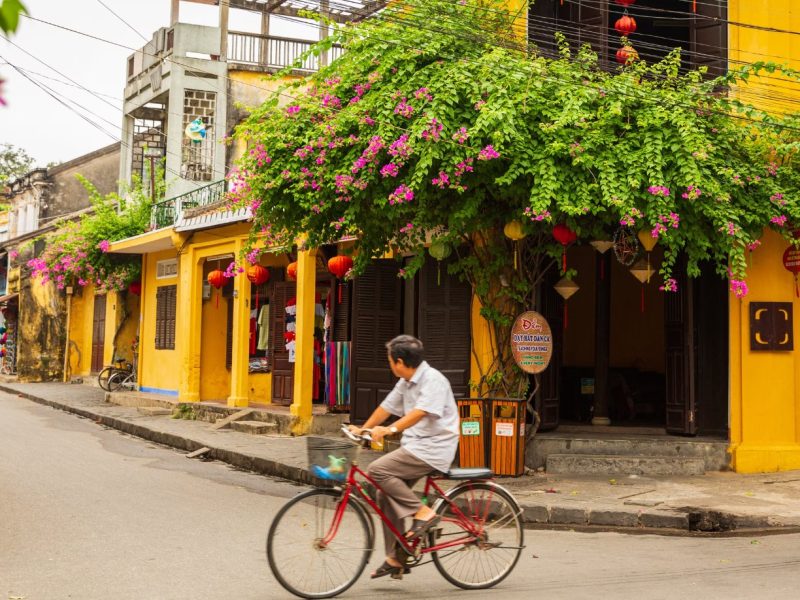
See more:
2. Where Is Hoi An Ancient Town?
Hoi An city is divided into two areas: Hoi An ancient town and the rest. Currently, Hoi An ancient town belongs to Hoi An city in Quang Nam province. Hoi An Ancient Town is located downstream of the Thu Bon River in the coastal plain of Central Quang Nam Province, about 30km south of Da Nang city. The transportation route is extremely convenient, so it is often combined with tourist attractions: Da Nang, Hoi An, and Ba Na Hills.
The old town is located in Minh An ward, with an area of about 2 km2. Hoi An ancient town is located on main roads close to the river bank, such as Bach Dang, Nguyen Thai Hoc, Phan Chau Trinh, Tran Hung Dao, Tran Phu, Le Loi, etc.
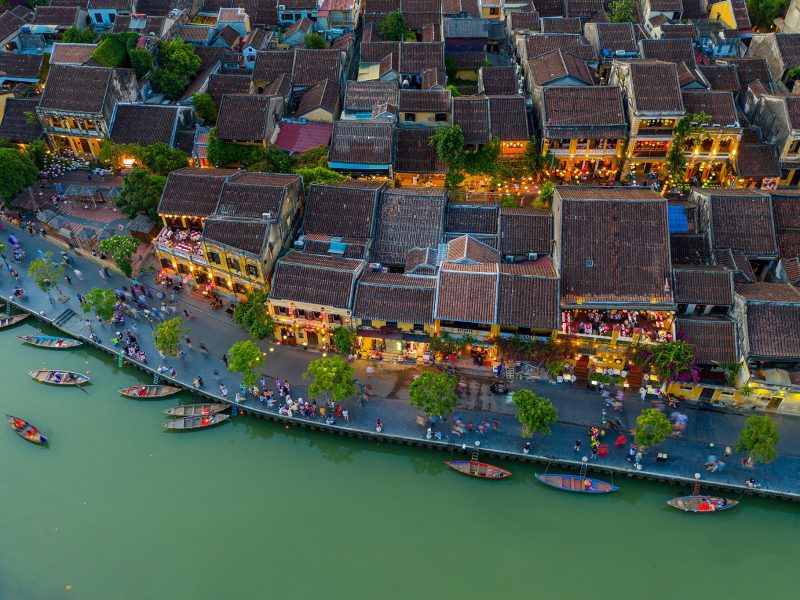
3. History of Hoi An Ancient Town
Hoi An Ancient Town was born in the second half of the 16th century, during the period when the Le Dynasty achieved its greatest prosperity. This street was built with a combination of Vietnamese, Chinese, and Japanese architecture. Throughout the 17th and 18th centuries, this place was a busy international trading port for our country, a place for trading exchanges with many merchants from China, Japan, and Western countries. Also in this area, there used to be a Champa trading port, known as the maritime silk road.
Westerners in the past called Hoi An by the name Faifo, which means urban—a trading street with a port. But this is only considered a calling name, not an official name. But Hoai Pho was the official name of Hoi An at that time. And the name Hoi An today was known a long time ago, and it is unknown exactly when. During the Le Dynasty, the Thien Nam Tu Chi Lo Do map contained the first names of Hoi An Pho, Hoi An Da, and Hoi An Kieu.
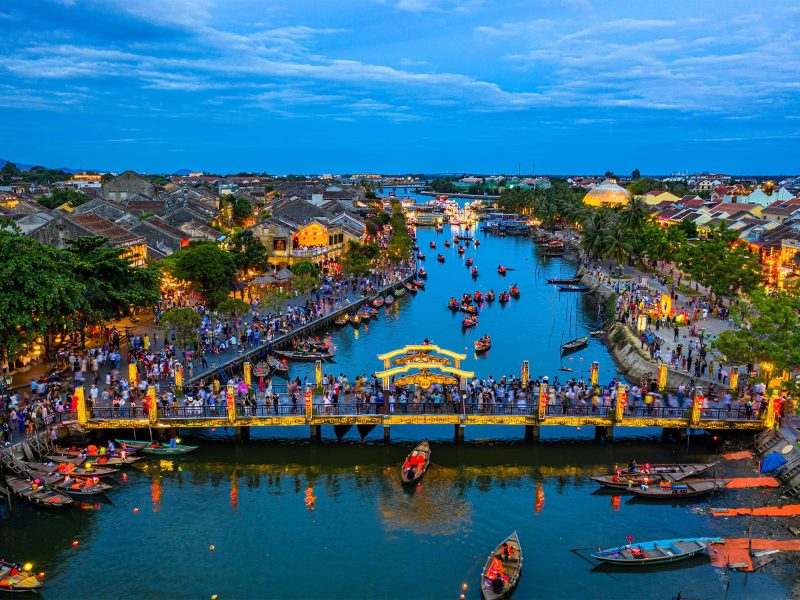
4. In what year was Hoi An Ancient Town recognized by UNESCO as a World Cultural Heritage?
Hoi An Ancient Town was recognized by UNESCO as a World Cultural Heritage on December 4, 1999. Hoi An Ancient Town was recognized based on two criteria:
Hoi An is an outstanding physical manifestation of the combination of multilateral cultures through the ages in an international trading port.
Hoi An is a typical example of a completely preserved traditional Asian port town.
5. How far is it from Da Nang to Hoi An Ancient Town? How long does the travel time take? What Means of Transportation?
The distance from Da Nang to Hoi An is about 30 km south. Travel time will depend on the vehicle used, as follows:
- Motorbike: It usually takes about 45 to 50 minutes to go from Da Nang to Hoi An.
- Bus: Travel time by bus is from 70 to 80 minutes.
- Car: For cars, the expected travel time is 45–55 minutes. However, this time may vary depending on traffic and road conditions.

6. What is the weather like in Hoi An Ancient Town tour?
Because it is located in a tropical climate area, Hoi An’s weather is also warm all year round; the average temperature in Hoi An is 29 degrees Celsius. Hoi An also has two main seasons: the rainy season and the dry season.
The rainy season in Hoi An lasts from September to January of the following year. However, Hoi An’s rain is also very gentle and creates extremely romantic scenes. Tourists who love quiet, not too noisy and bustling, this is the ideal time for a trip to explore Hoi An. The dry season in Hoi An starts from February to August. The dry, sunny weather will be very suitable for a sightseeing trip. This is the time when Hoi An welcomes the most tourists of the year.

7. Typical architectural relics of Hoi An
Hoi An is an ancient town with typical architectural works that have survived many years of history. The old town is the intersection of Vietnamese, Chinese, and Japanese architecture, imbued with quiet ancient features.
7.1 Pagodas, temples
Hoi An carries within itself the beauty of peace and ancient features. Coming to Hoi An, there are many pagodas and temples that were built a long time ago with unique designs left by ancient artisans until now. Tourists traveling to Hoi An can visit Ba Mu Pagoda, Ong Pagoda, Chuc Thanh Pagoda, etc.
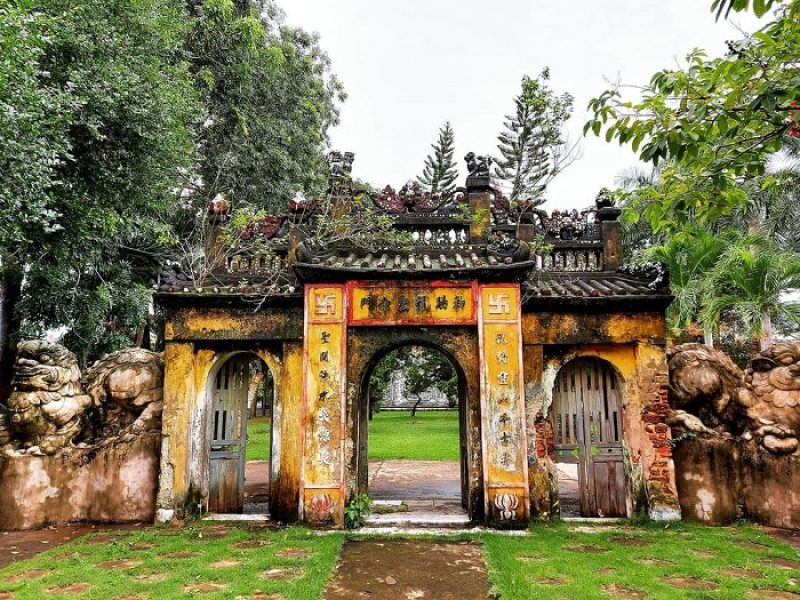
7.2 Old house
Ancient houses are also one of the factors that create the cultural and historical value of Hoi An ancient town. When mentioning ancient houses in Hoi An, people will immediately think of Tan Ky ancient house, Quan Thang ancient house, Phung Hung ancient house, etc.
7.3 Assembly Halls
Assembly halls in Hoi An are typical architectural works that were conceived and built by ancient artisans. Coming to Hoi An, you can visit assembly halls with typical architecture, such as Fujian Assembly Hall, Guangdong Assembly Hall, Ngu Bang Assembly Hall, etc.
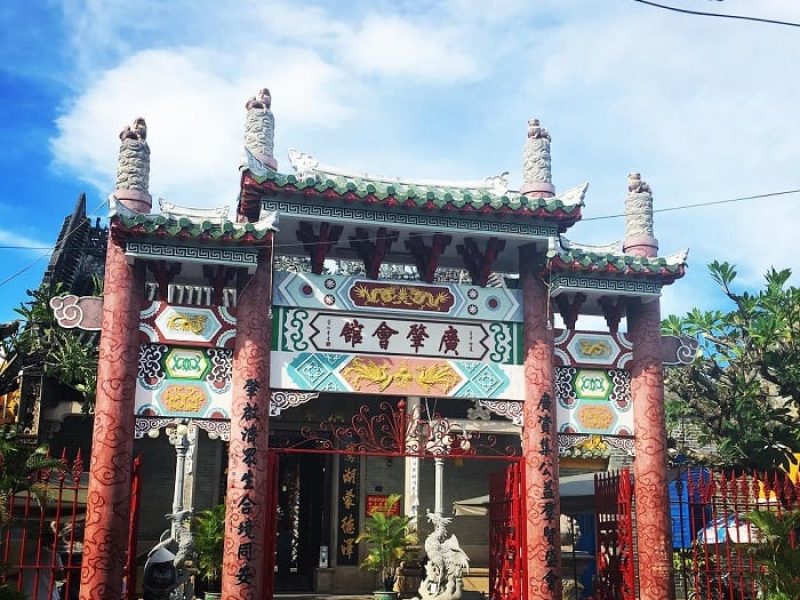
7.4 Chua Cau
Chua Cau is considered the main symbol of Hoi An, an ancient town. Chua Cau was built by Japanese merchants who came here to trade and build in the mid-16th century. Chua Cau was therefore built in a style combining Japanese, Chinese, and Vietnamese. Chua Cau has gone through many years of ups and downs in history and has truly witnessed Hoi An step by step and developed step by step until today.
8. Culture in Hoi An ancient town
8.1. Folk culture, cultural beliefs, religion
Referring to Hoi As a culture, it is impossible not to mention folk music and traditional games. The forms of folk performances and games here crystallized from the labor processes of local people and are still fully preserved today. These can include lead-pulling chants, drill chants, anchor-pulling chants, rhyme rhymes, ly tunes, forms of tuong singing, ba trao, chant bai choi,etc.
Regarding cultural beliefs, Hoi An people have the custom of worshiping the Ngu Tu Gia Duong, worshiping Quan Cong (popular in urban areas) in addition to worshiping ancestors. Regarding religion, in Hoi An, there are many different religions, such as Buddhism, Cao Dai, Protestantism, Roman Catholicism, etc. However, Buddhism still occupies the leading role.
8.2. Traditional festivals
Hoi An still preserves many types of traditional festivals, such as religious belief festivals,festivals honoring village tutelary gods,festival commemorates the masters of the profession, etc. The most important is the communal house festival in the villages on the outskirts of the urban area. Normally, each village has a communal house to worship the tutelary god and his predecessors. In addition, Hoi An culture also preserves many other traditional festivals, such as the Long Chu Festival, Boat Racing Festival, Cau Ngu Festival, Cau An Festival, and Full Moon Night Festival in the Old Town, etc.
8.3. Folk cuisine
When it comes to Hoi An cuisine, there are truly countless dishes that have been closely associated with the daily lives of local people here but have since become delicious and strange dishes for tourists who want to experience them. Some of the dishes that have created the culinary value of Hoi An ancient town include cao lau, Quang noodles, white rose cake, dam cake, stir-fried mussels, or bread.
9. Do you buy tickets to Hoi An Ancient Town?
If you just walk around, take photos, and admire the beautiful scenery in the old town, it is completely free without needing to buy a ticket. However, if you want to visit and learn about other heritage sites in the old town, you must buy a ticket to enter. Places where tickets must be purchased in the Hoi An ancient town tourist area:
Ancient Houses: Phung Hung Ancient House, Duc An Ancient House, Quan Thang Ancient House
Assembly Hall: Fujian, Chaozhou, Quang Trieu and Hainan
Museum: Mau Dich Ceramics, Folk Culture, Sa Huynh Culture, Hoi An
Cultural works: Covered Bridge, Cam Pho Communal House, Quan Cong Temple, Tuy Tien Duong Minh Huong
Churches: Toc Tran Church, Toc Nguyen Church
Tombs of Japanese merchants: Gu Sokukun, Tani Yajirobei, Banjiro
Traditional art performances, folk games, experiential activities.
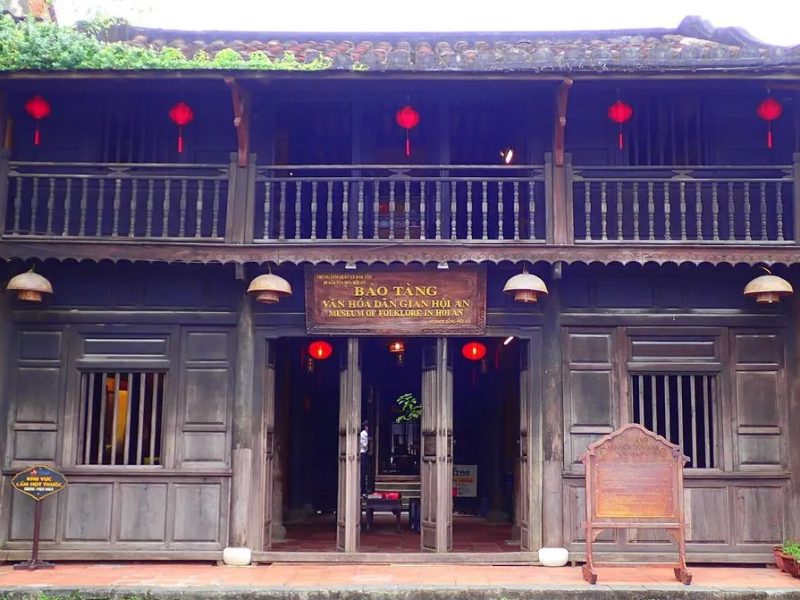
According to the regulations of the People’s Committee of Hoi An city, ticket prices to visit Hoi An ancient town 2023 are as follows:
- Ticket price to visit Hoi An for Vietnamese tourists: 3.29 USD/person
- Ticket price to visit Hoi An for international visitors (foreigners): 4.94 USD/person
In addition, for groups of 8 or more guests, the tour guide fee will be waived instead of having to hire one. Just contact the ticket sales staff to take advantage of this offer. However, there are some things to note:
All visitors entering the heritage area only need to buy a ticket once, so remember to keep the ticket to present during the visit.
Ticket prices are only valid within 24 hours for visiting monuments in the old town area.
10. What Time Does Hoi An Ancient Town Close?
The starting time for sightseeing in Hoi An ancient town is from 7:00 a.m to 21:00 p.m every day. The operating hours of other services are as follows:
From 9:00 a.m to 11:00 a.m. and from 15:00 p.m to 22:00 p.m, Hoi An prohibits vehicles from entering the old town. So you can park your car and comfortably walk around the old town during this time.
From 17:30 p.m to 21:00 p.m every day, there will be an art performance imbued with Hoi An’s traditional cultural identity at 66 Bach Dang or 39 Nguyen Thai Hoc.
From 19:00 p.m to 21:00 p.m, there will be a folk music performance at 78 Le Loi and a piano performance at 106 Bach Dang.
The time is from 9:00 a.m to 11:00 a.m and from 15:00 p.m to 21:00 p.m performing the “cat rot ren song” program at Hoai River in front of Chua Cau.
Hoi An night market opens from 17:00 p.m and ends at 23:00 p.m every day on Nguyen Hoang street. Here you can buy handicrafts as gifts or souvenirs when visiting the old town.
11. The time of the lantern festival
Organizing time: from 18:00 p.m – 21:00 p.m 1st, 14th, and 15th (lunar calendar) of every month and every Saturday
The price of a lantern is 0.41 USD per lamp, and the price of a boat seat is 3.97 USD to 4.93 USD per boat.
You should choose the dry season from March to September to fully see the beauty of the Hoi An lantern festival!
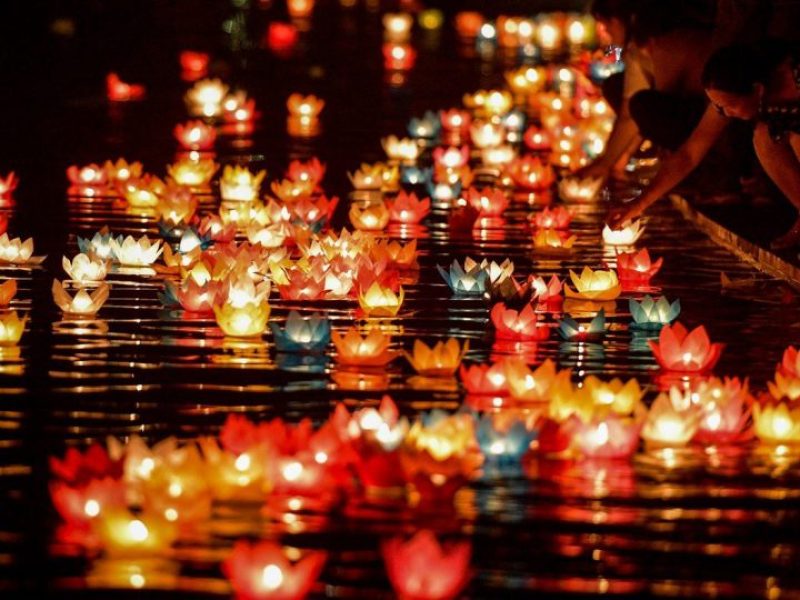
12. Exploring Hoi An Ancient Town Should you go on your own or take a tour?
Hoi An Ancient Town is a tourist destination with many traditional cultural values; if you are not a native, it will be difficult for you to fully understand that beauty. With a tour from a local travel tour company, you don’t need to worry about places to play, where to stay, or where to eat; all of these services are planned by the tour guide and the company for you. There are many travel companies organizing tours to Hoi An Ancient Town. One of the reputable and famous local travel operators you can choose for your Hoi An ancient town tour is Metta Voyage.
Metta Voyage established in 2019, it has soon become a health care resort tour operator in Southeast Asia that is trusted and chosen by many customers. Metta Voyages specializes in providing services such as package tours for domestic and international customers, health care tours, domestic and international air tickets, hotels, car rental services, and many more services. Please contact Metta Voyage immediately to schedule your trip and enjoy the best services!
Conclusion
Above are the top 12 things to know before you experience the Hoi An ancient town tour that Metta Voyage shared. Hoi An, an ancient town, is truly a place worth experiencing. Don’t hesitate any longer; contact Metta Voyage immediately to schedule your trip right away.
Contact us
Website: www.mettavoyage.com
Email: info@mettavoyage.com
Hotline 24/7: + 84 989 383 572

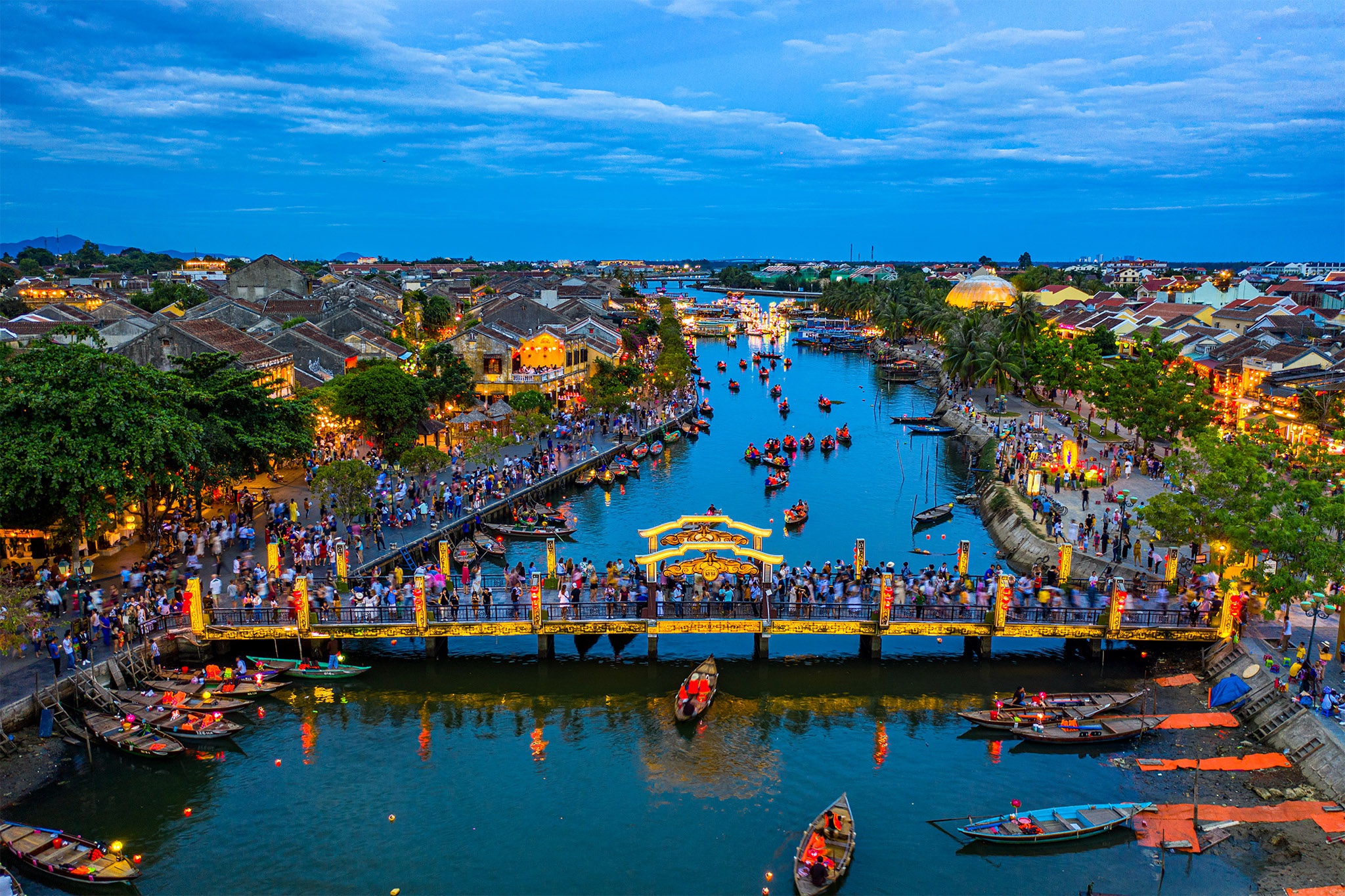

0 Comment